Introduction
- It is one of the leading rail transport companies in US.
- It deals with freight intermodal shipments, transportation of minerals such as coal, Iron Ore and Coke.
- It also deals with transportation of cars, car parts, and lumbers.
- The company has transportation services for commuters both long distance and short distance.
- NS Corp has 4 different types of railways:
- Norfolk and Western Railway;
- Southern Railway;
- Conrail and Pocahontas Land Corporation.
- It has a vision to efficiently and effectively transport Cargo while expanding to different areas of the world.
- It maintains its competitive advantage through good management and Innovation.
- An example is the newly developed Green Machine which aimed at sustainable development which had three innovative objectives
- To improve the economy;
- To consider the people;
- To reduction of carbon emissions.
- An example is the newly developed Green Machine which aimed at sustainable development which had three innovative objectives
- The company contributes to the economy and the people through the following:
- The Economy
- Through improving the rail transport system, the company improves on its revenues;
- This improves the economy.
- The people
- Norfolk has a consumer oriented strategy;
- Customers get what they want at the right time in the right place and at agreed terms and conditions;
- The company also ensures environmental safety by reduction of carbon emissions.
- The Economy
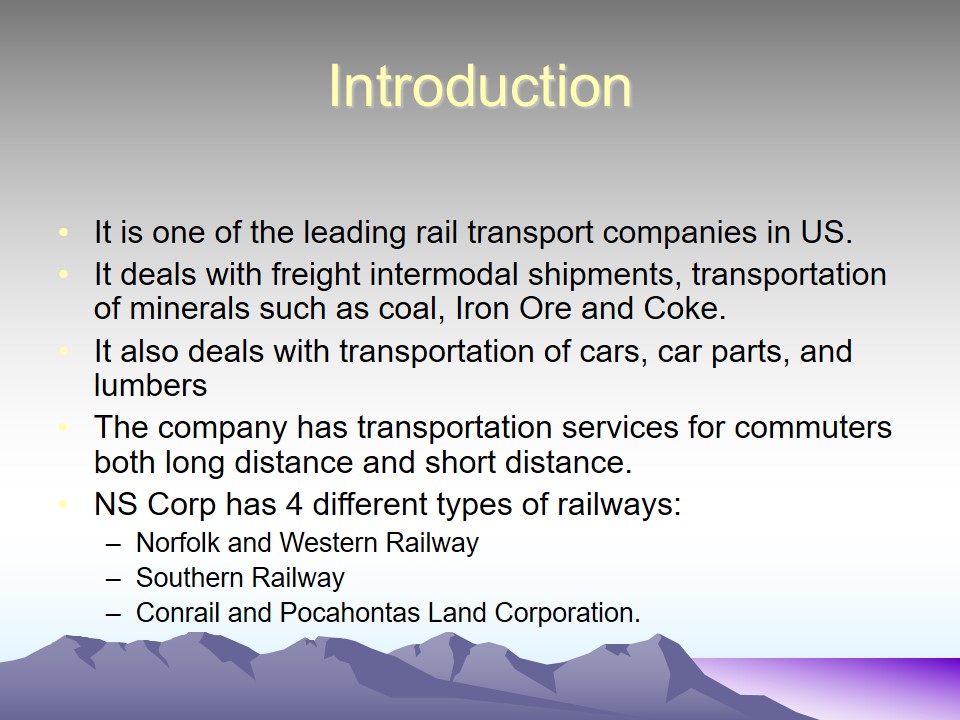

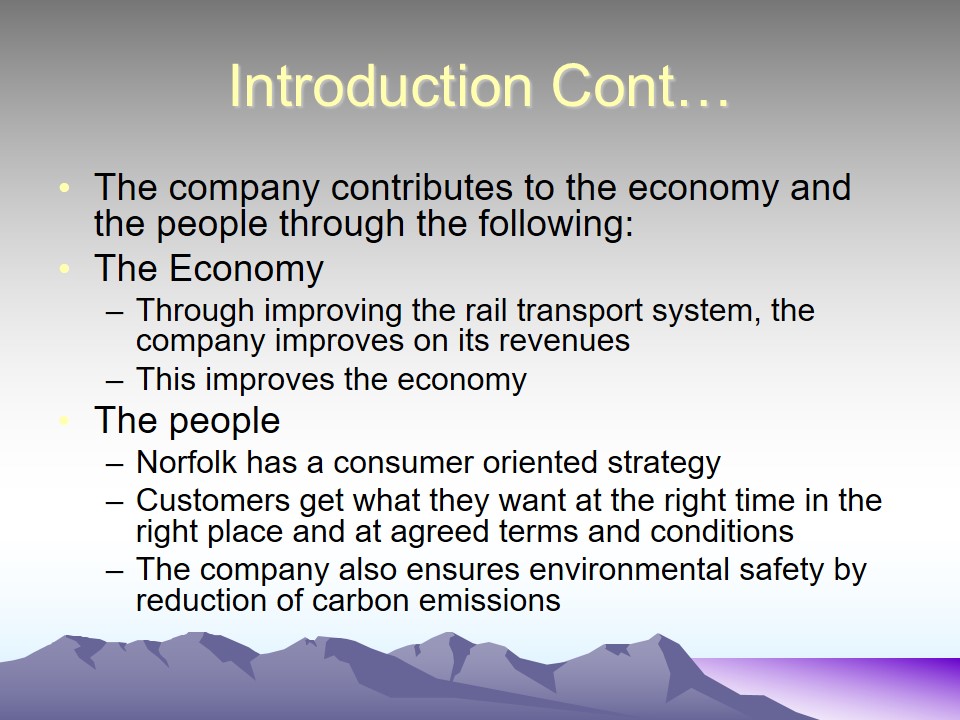
History
- It was started in 1838 by William Mahone.
- Initially it was South Carolina Canal and Rail Road Co in 1833.
- Was bought is1881 by E.W Clark and CO then expanded to West Virginia, Columbus, Cincinnati, Durham and Winston-Salem.
- Formed the Southern Railway through a merger between East Tennessee, Virginia & Georgia and Richmond & Danville system Railroads in 1884.
- In 1901, NW Railway Company acquired Pocahontas Coal and Coke Company.
- 1939 it became Pocahontas Land Corporation.
- Merged into NW in 1959.
- Expanded further under the leadership of Samuel Spencer.
- Central Georgia became part of it in 1963.
- In 1968 it became Penn Central after merging with their largest competitor, New York Central.
- Filed bankruptcy in 1970.
- Joined by Norfolk Southern railway in 1974.
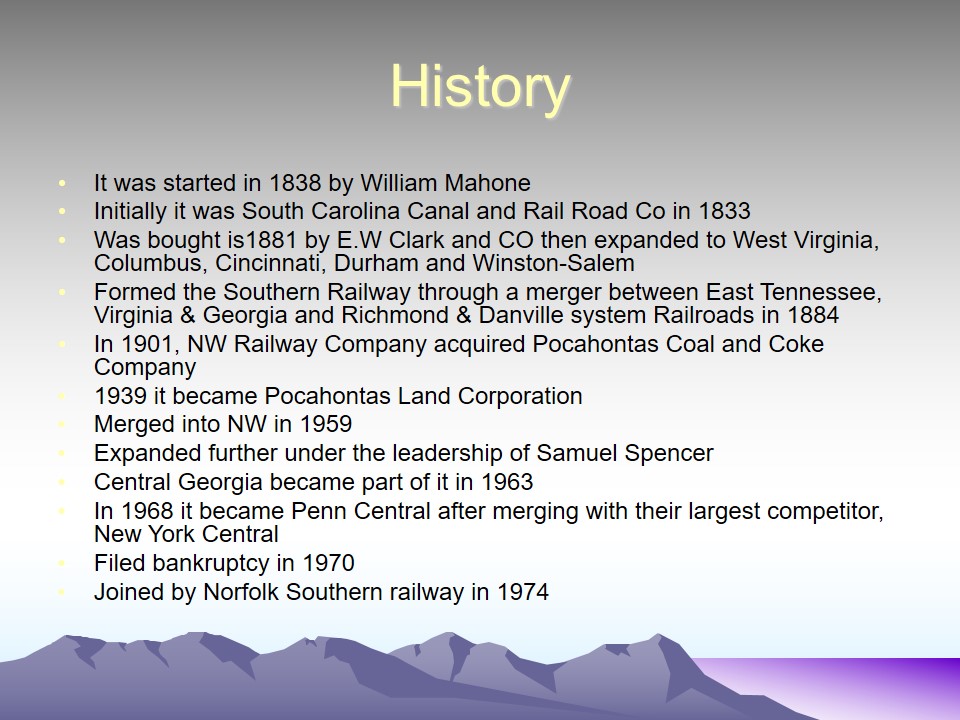
Marketing Strategy
- The company developed a consumer focused marketing strategy.
- This strategy focuses on consumer preferences, needs and ensures satisfaction.
- It has different business groups that operate under different management to achieve its goals.
- Each group has to develop the consumer focused strategy.
- This strategy is dependent on the business group.
- In this paper, the coal group is given as an example.
- Norfolk Southern Corporation’s Coal Group
- Is divided in three functional areas:
- Coal transportation services account management,
- Marketing, sales and other commercial matters,
- Planning and management of Coal resource development and Coal transportation services.
- Is divided in three functional areas:
- Consumer satisfaction is done through logistic management.
- Marketing is done considering consumers’ delivery specification as the market segments.
- Coal group is further divided into:
- Steam coal marketing;
- Domestic metallurgical coal, coke and Iron Ore Marketing;
- Industrial coal, coke and Iron Ore Marketing;
- Export, coal, coke and Iron Ore Marketing.
- All the groups ensure marketing is done effectively.
- Each group has its ways of achieving the aim of the company’s marketing strategy which is to maintain customers and attract more.
- Marketing is supported by various departments of the organization for example Modalgistics Supply Chain Solutions (MSCS).
- The department offers supply chain services aimed at consumer satisfaction.
- They are;
- Supply chain based consulting;
- Innovative operations planning and management;
- Industry leading asset management technology.
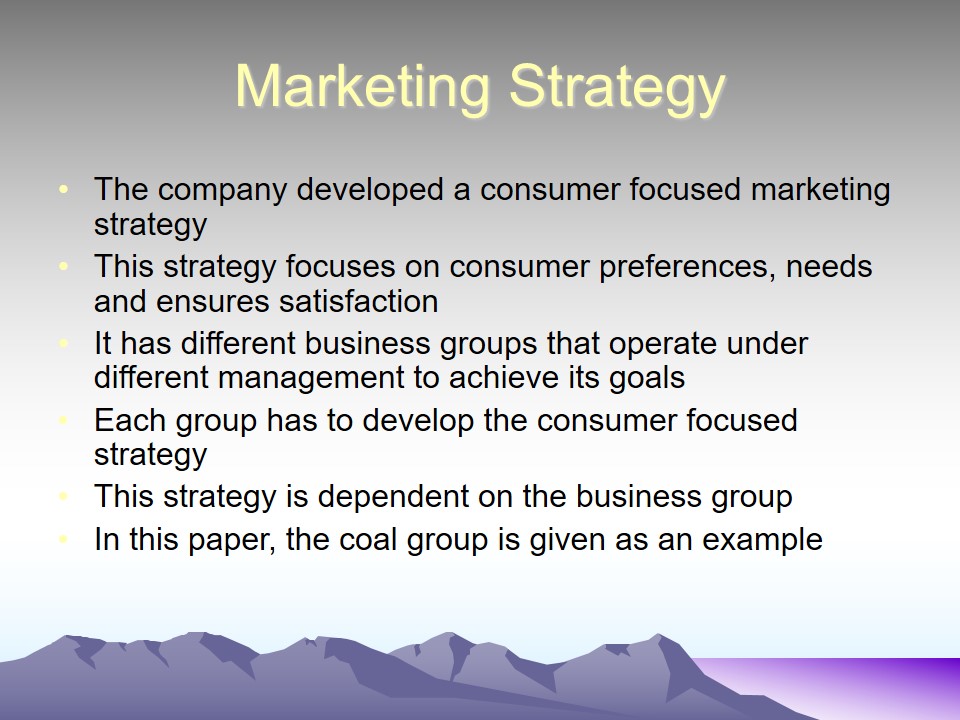
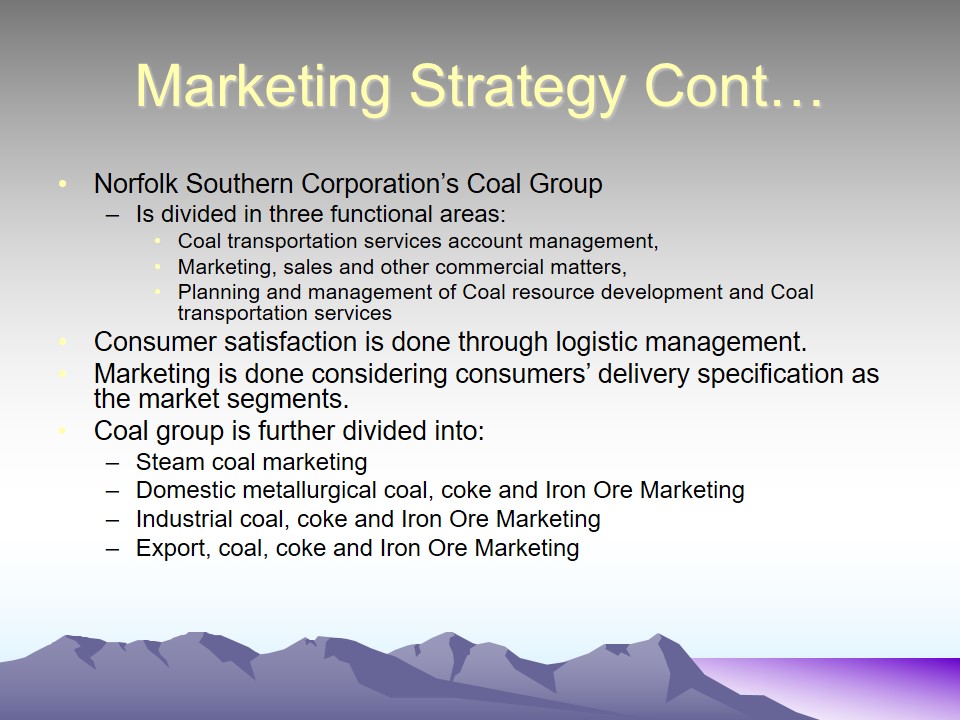

The Role in Supply Chain
- Supply chain is the link between customers and suppliers.
- The activities and businesses of NS address the organization of the supply chain.
- The company ensures delivery of goods from one destination to the other.
- It delivers goods from suppliers to various retailers and even wholesalers.
- Norfolk Southern Corporation’s operations are driven by a profound history of prosperity in providing efficient, economically, and environmentally added services and continuous customer satisfaction.
- It therefore provides the link between producers/suppliers and the consumers of the goods.
- The role in this link is transportation.
- The rail transport company offers intermodal services for different shipments from one area to another.
- An example is transportation of refrigerated trailer shipments between Los Angeles and Atlanta.
- The corporation’s Modalgistics business unit works with customers to ensure customized supply chain solutions.
- It makes use of logistic providers, management consultants and technology providers to ensure reduced operating costs, free tax capital, enhanced revenue and free working capital.
- Norfolk Southern Corporation’s supply chain services combine technology with industry specific expertise to produce continuous supply chain solutions.
- Norfolk Modalgistic business unit ensures that every shipment is in the right mode.
- Product deliveries are made through intermodal means, rail, parcel or truckloads.
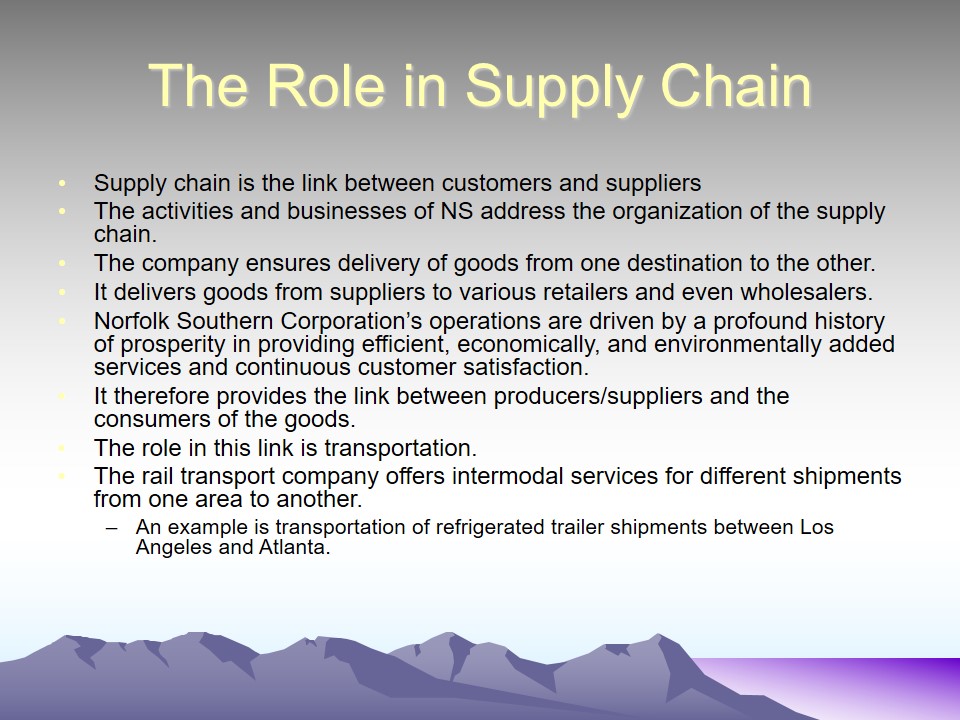
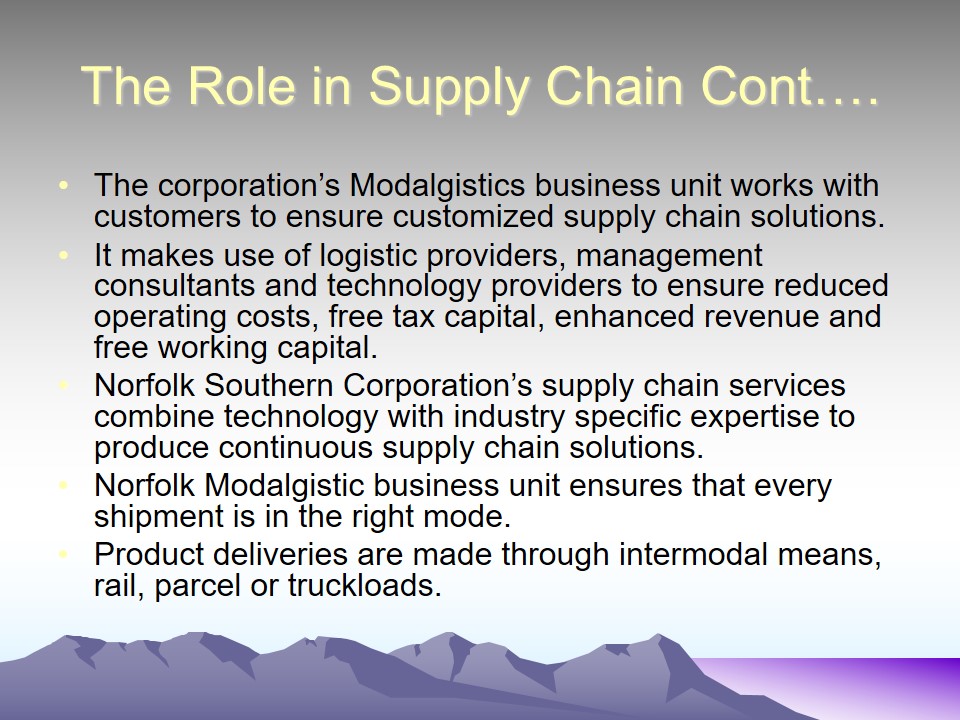
Economic Analysis
- Economic factors of any region affect businesses of any kind.
- Below are the economic factors that have affected the company.
- Increased fuel price;
- Recession;
- Weak international business.
- Norfolk Southern Corporation has been affected by reduced demand due to recession.
- The company’s second-quarter earnings reduced to 45% due to reduced shipping demands.
- Weak international business affected the intermodal shipments.
- Some important results about revenue collection are as follows:
- General merchandise revenue decreased to 33%.
- Coal shipping reduced 34%.
- Sales from intermodal transportation dropped to 31%.
- The operation expenses also reduced to 29%.
- The company resorted to development of new projects and discounting to remain in business.
- These results show that the company is not in a very good business position currently.
- The company however has a strong competitive position, the ability to continue expanding and opportunities for growth from unexploited markets.

Impact on Globalization
- Globalization is the growth and differentiation of various sectors or industries in the world.
- It is characterized by affordability, diversity and availability of goods, new cultures in different places and new technologies.
- Norfolk Rail transportation has contributed to globalization through two ways:
- Transportation of goods and people from one area to the other.
- Transportation of tourists contributes to the changing cultures.
- Transportation of goods to different regions leads to availability and diversity of the goods in such areas.
- Development of new technologies in their operations.
- In the quest to improve their services and satisfy consumers, they develop new technologies.
- This is supported by new technologies that keep on emerging.
- Transportation of goods and people from one area to the other.
- Norfolk SC rail transport system has also been globalized due to trade and globalization in other industries.
- Norfolk has changed with improvements on capacity of goods carried generally, volume, efficiency and speed.
- The company’s modem international railway transport system has shaped global production and markets, and has linked manufacturing activities to global markets.
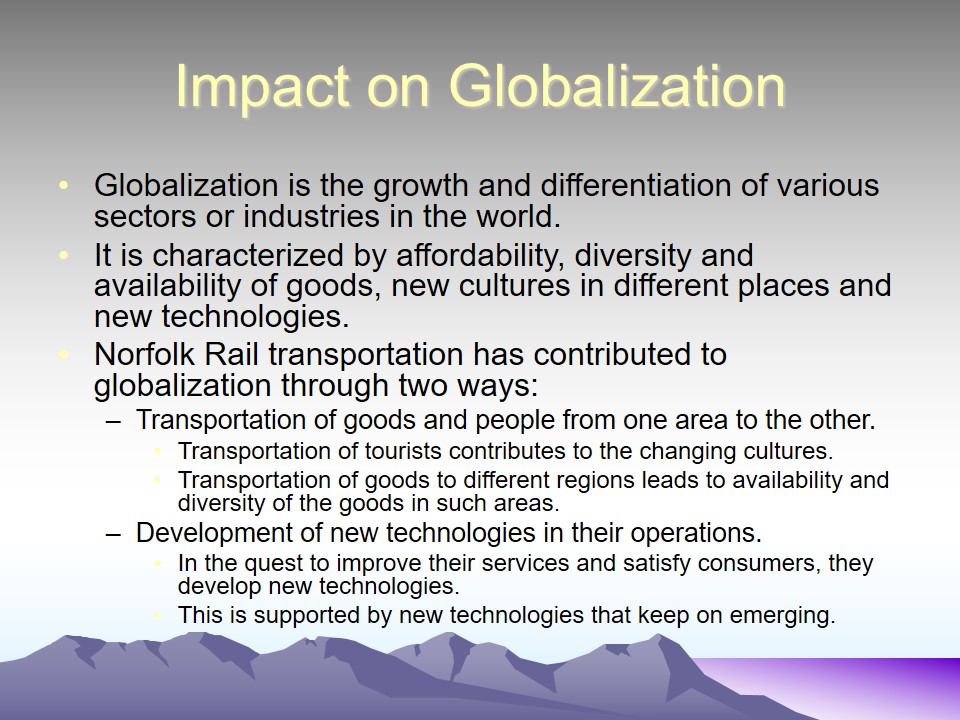

Norfolk Southern Corporation’s Current Issues
- This section considers the company’s current issues based on the security, projects, labor shortage, RFID and Freight damages.
- Security:
- It has improved its security by implementation of NICE’s 7-digit transportation project
- The aim was to capture, manage and analyze rail communications
- The company aimed at improving incident reconstructions and their investigations
- It has improved its security by implementation of NICE’s 7-digit transportation project
- Labor shortage:
- The company is currently experiencing shortage of engineers due to technological revolution, changing consumer requirements and development of new ideas in the rail transport industry.
- The problem is lack of enough engineers with updated skills due to;
- Lack of training the necessary skills.
- Competition for the already trained skills from other industries.
- Freight Damages:
- The company operates efficiently and delivers goods with little freight damages.
- This efficiency has been contributed to by demand rise between 2004 and 2005.
- RFID-Radio Frequency Identification Data:
- The company uses this system in its supply management due to improved operations and methods in the rail industry, competition, new technologies and the quest to provide quality services.
- Norfolk’s RFID is currently used for provision of freight shipment information, shipments auditing and for data supply.
- These are important in logistics and transportation management.
- Projects:
- Norfolk resorted to implementation of new projects to remain in business.
- The company currently aims at building another intermodal terminal (announced on July, 16th).
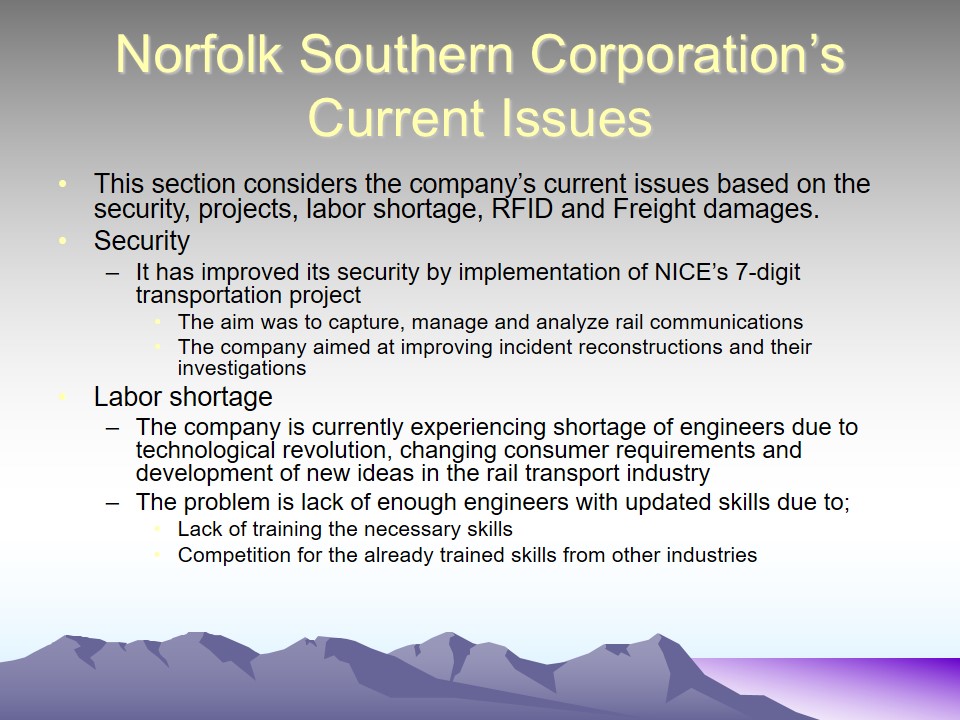
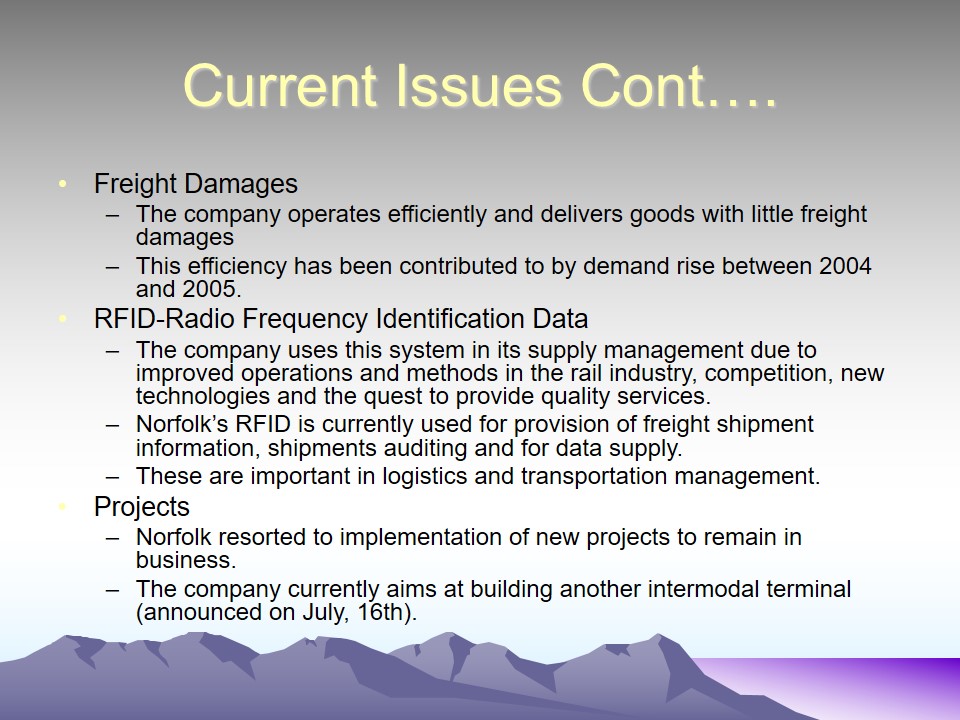
Conclusion
- Norfolk has grown to a level where it is the leading company in the rail transport industry in US.
- Its position is maintained by its effective management and marketing strategy used in each business unit.
- It also plays a very important role in the supply chain by transporting goods to consumers from suppliers.
- The current situation however has destabilized the company having reduced revenues due to weak international business and recession.
- The company has also contributed to globalization of the rail transport industry through its operations and innovations.
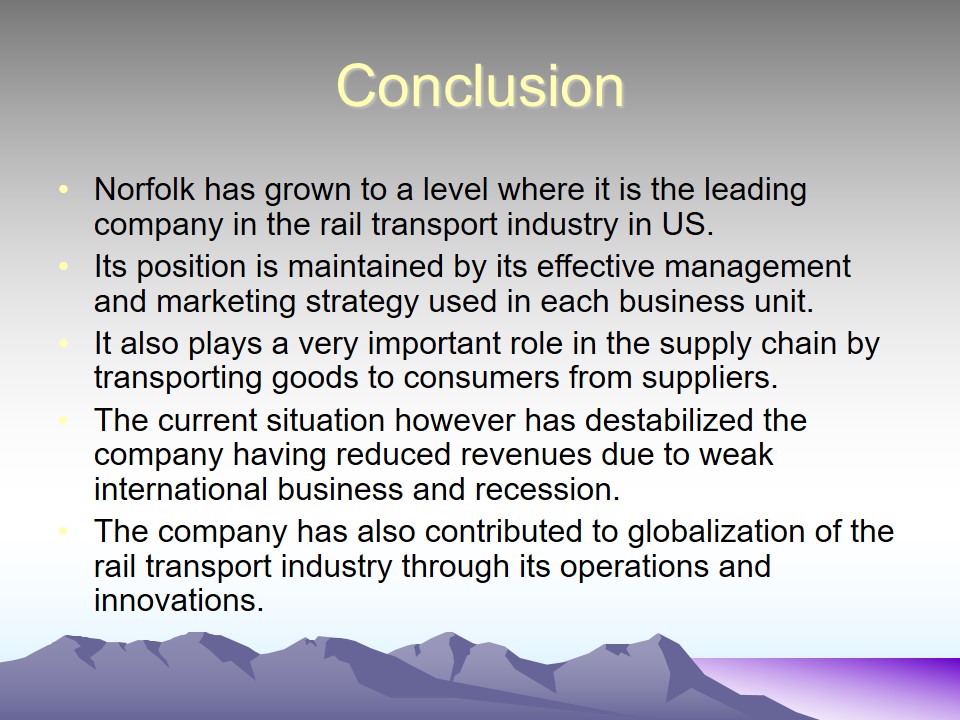
Reference List
- Associated Press a. (2009). Norfolk Southern 2Q profit plunges 45 percent. Bay News 9. Web.
- Associated Press b. (2009). Norfolk Southern 2Q profit plunges 45%. World Now and WRIC. Web.
- Beachey, A. (2008). Skills Shortage in the Rail Sector. Railway Technology. Web.
- Berman, J. (2009). Railroad/Intermodal Shipping: Norfolk Southern, Union Pacific Launch Intermodal reefer Service. Logistics Management. Web.
- Bureau news. (2009). Norfolk Southern Sees demand will reach Worst level this Quarter, Might Pick up in Second Half. Taragana. Web.
- Community. (n.d.). Web.
- Congress of the United States. (2005). Freight Rail Transportation: A Review of the 2004 Experience. A CBO Paper. Web.
- Environmentally Friendly. Proquest Career & Technical Education. p. 104. Web.
- Forbes.com . (2009). Norfolk Southern Corp (NYSE: NSC): Buy/Hold/Sell Analysis. ZACKS Investment Research. Web.
- Gourdin, K. N. (2001). Global logistics management: a competitive advantage for the New Millennium. New Jersey, US: Wiley-Blackwell.
- Kell, J. (2009). Norfolk Southern Hit by Demand Drop, 2009. Dow Jones & Company. Web.
- Modalgistics Supply Chain Solutions (2009). Consultancy, Technology and Operations. Norfolk Southern Corporation. Web.
- NICE. (2008). NICE Wins 7-digit Transportation Project from Norfolk Southern Corporation. NICE Systems Limited.
- Norfolk Southern Corp. (a) (2009). Coal Business Group. Web.
- Norfolk Southern Corp. (2008). James A. Squires, Executive Vice President Finance and Chief Financial Officer Norfolk Southern Corporation’s Remarks on NYSE Euronext Investment Conference Tokyo, 2008. Web.
- Norfolk Southern Corp. (b) (2009). Norfolk Southern Selects Greencastle Site for New Franklin County Regional Intermodal Facility, Supporting Crescent Corridor Initiative. Web.
- Rodrigue, J. P. (2009). Transportation and Globalization. Department of Economics & Geography, Hofstra University, Hempstead. Web.
- UNIVERSUMUSA. (2008). Transportation: RFID Technology.